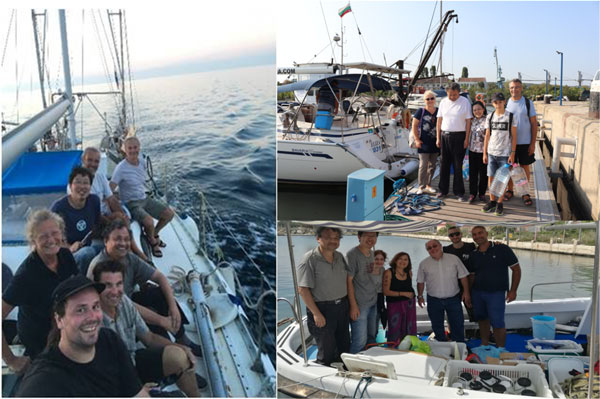
Newsroom
A Union Cruise including Scientists from “Belt and Road” Countries Set Sail

Prof. ZHOU Yiyong guided his team to Europe to conduct the cruise in Black Sea (right upper), Adriatic Sea (left) and Ionian Sea (right bottom) in Mediterranean Sea, from August to September, 2018.
Harmful algal blooms (HABs) cause significant economic and ecological damage worldwide. Despite considerable efforts, a comprehensive understanding of the factors that promote these blooms has been lacking.
A special project of strategic international innovative cooperation in science and technology innovation, with the title of “Mechanisms of red tides and hypoxia as ecological marine disasters and technologies for its early warning along the ‘Belt and Road’ countries” was supported by the Ministry of Science and Technology of China.
Scientists majoring in ecology, phycology, chemistry, biochemist, microbiology and toxicity from China (including Chinese Taiwan), Russia, Italy, Malaysia, Bulgaria and Slovenia were involved in this international project. Professor ZHOU Yiyong, from Institute of Hydrobiology (IHB) of Chinese Academy of Sciences serves as the chief coordinator.
“The Black Sea had a long history of HABs, which had strong negative impact on marine water quality and tourism. The synthesized long-term data showed that increase of nutrients and organic substances enhanced the algal production in the Black Sea to pathological levels. Thus phytoplankton, being the first target of nutrient alterations, was perceived to be a decisive factor for marine water quality and ecosystem health. The superfluity of the Black Sea (when the ecosystem was replete with nutrients and phytoplankton) for many years dictated that urgent steps should be taken to better understand and manage harmful algal species and the resources they threaten.” said Professor Daniela PETROVA, director of Institute of Fish Resources of Bulgaria, one of the participants in this project. A dinoflagellate bloom dominated by Scrippsiella trochoidea was detected during the union cruise in the Varna bay of Black Sea.
Professor Michele GIANI, who organized the joint research survey and laboratory analyses, participated in the project on behalf of National Institute of Oceanography and Experimental Geophysics (OGS) in Italy. The survey and analyses included three researches from IHB, three researchers from Jozef Stefan Institut of Slovenia and nine researchers and technicians from OGS Oceanography Division of Italy. The aim of the survey was to identify and study the sediment-water interactions in an area under the seasonal low oxygen (hypoxic) conditions. A hypoxic area was identified in the bottom waters of Gulf of Trieste in Adriatic Sea during the survey from 12-13 September.
Professor Gabriella CARUSO from Institute for coastal marine environment, Commission on Natural Resources in Italy organized a Sino-Italy cruise in Ionian Sea in Mediterranean Sea, focusing on the area aroud marine aquculture.
“The increasing frequency and severity of HABs or red tides is of critical concern both with regards to maintaining ecosystem health as well as ensuring safe and equitable provision of marine food products. Predicting where, when, and under what environmental conditions HABs will occur has further been inhibited by a limited understanding of the mechanism underlying the occurrence and development of red tides. We will benefit from this cooperation, since a better understanding of the holistic way of ecosystem and management in Black Sea and Mediterranean Sea may inspire novel answers to the challenges facing South China Sea” said Professor ZHOU, the chief coordinator of the project.